DISCOVER MORE GALLERIES AND ATTRACTIONS NEAR NICE
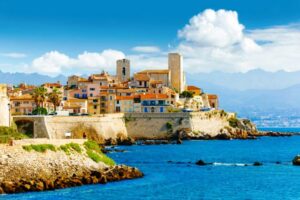
There are so many great attractions to explore along the Riviera, and we’ve looked at just a few of these in the last couple of blog stories. The department of the Alpes-Maritimes is characterised by a profusion of artistic and cultural institutions—there are said to be more than 62 museums and foundations which bear witness to the attraction for so many artists during the 20th century to the light and environment of the Côte d’Azur. Here we’ll look at a couple more outstanding art museums and sights that can be easily done as day trips from Nice. We love to visit these when we can while in the neighbourhood, as they offer art works we enjoy in this beautiful environment. Even getting to these is a visual delight, either along the coast or up into the hills, where you can see hilltops crowned with villages and beautiful villas.
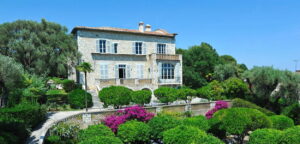
At Cagnes-sur-Mer, a little over 13 kms from Nice heading towards Cannes, is the house museum of one of the country’s most beloved artists, Auguste Renoir. The painter discovered Cagnes-sur-Mer in 1903 on his way to Italy. In 1907 he bought the Domaine des Collettes, a large property of several hectares, with beautiful gardens composed of centuries-old olive trees plus a grove of orange trees, typical Mediterranean plants and an uninterrupted view of the sea.
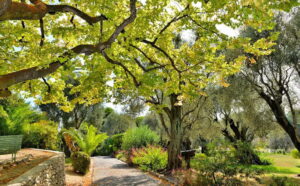
As the existing small farmhouse wasn’t suitable for the artist and his family, he built a large neo-Provençal style house which also had two artist’s studios. Surrounded by his family, consisting of his wife Aline and his 3 children Claude, Jean and Pierre, he never left the Riviera. He painted and sculpted there for 11 years until his death on 03 December 1919 at the age of 78. During his life there, the villa became a lively place of intellectual, artistic, cultural and social life, where he received friends such as other great artists of his day including Henri Matisse, Claude Monet, Auguste Rodin, Amedeo Modigliani and Pablo Picasso, to name a few.
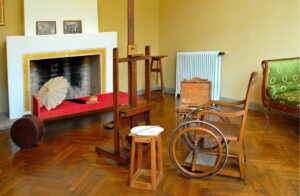
On his death, the property was left to Renoir’s son Claude, who lived there until 1960. It was also the location of a movie, ‘Picnic on the Grass’, a film directed by his son Jean. In 1960, the town of Cagnes-sur-Mer bought the property in order to establish a museum, where today visitors can discover the living environment that was home to the artist for some of the most productive and happy years of his life. It was here that he approached sculpture for the first time, although he became increasingly frail with severe rheumatoid arthritis that badly affected his hands, necessitating the help of an assistant for various tasks. However, Renoir never stopped painting. Rather than slowing him down, under the threat of total paralysis, he redoubled his activity and painted frenetically until his last day. The house has many personal mementos, and the park and gardens have exhibition spaces and sculptures, in a haven of peace and calm.
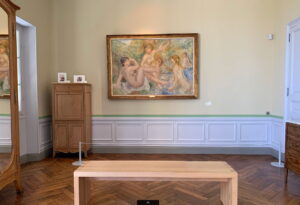
The house itself has 15 paintings that retrace the major themes beloved by Renoir, such as ‘The Bathers’ and ‘The Caryatids’ which represent the nude figure, ‘Coco Lisant’ and ‘Madame Pichon’ show the painter’s great talent for portraiture, while the paintings ‘La Ferme’, ‘Paysage aux Collettes’ and ‘La Vallée de la Cagne’ and ‘Le Baou de Saint Jeannet’ show the inspiration that the French Riviera provided for the artist’s landscapes. Visitors can admire such works as the bronzes of two portraits of Claude, or the bust of Aline destined for his wife’s grave. Various nudes are also presented, such as the ‘Judgement of Paris’ and ‘Venus Victrix’.
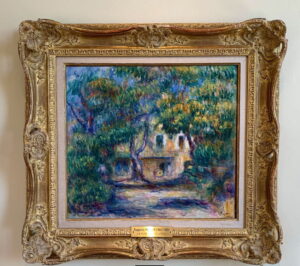
Note that the museum is closed on Tuesdays. To get there by bus from Nice, take the no. 620, 622 or 650, which depart from Parc Phoenix, the ride taking around 30 mins. Get off at the Gare Routiere (bus station), which is right across from the railway station, or take the train from Nice. From here during the summer there’s free shuttle from the bus station every 45 mins., otherwise, take bus no. 49 which takes you right to the museum. Check additional info. at the Nice Tourist Office.
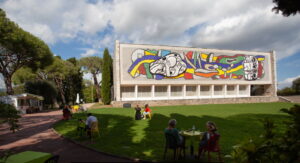
If, like us, you’re a fan of the works of Fernand Léger, the museum devoted to his works on the Riviera is a must-see. It’s located in Biot, a little under 20 kms from the heart of Nice, heading towards Antibes. The easiest way to get there from Nice is by train to Biot station, then the so-called Envibus no. 10 or no. 21 to the stop ‘Musée Fernand Léger’. The bus stop is about 5 mins. from the train station. The museum is closed on Tuesdays.
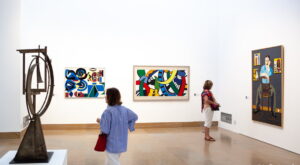
This is the only museum in the world dedicated to the works of this major 20th century artist, who lived and worked in Biot. A few months before his death in 1955, Léger bought a villa, the Mas Saint Andre, located at the foot of the village of Biot on unused agricultural land. His widow, Nadia and Georges Bauquier, his great friend and collaborator, decided to create a museum to pay homage to him and promote knowledge of his work.
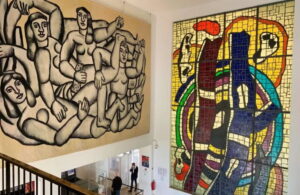
The museum was opened in May 1960, and was donated to the State in 1969 and included the building, the garden and nearly 350 works representative of the artist’s career. Léger was influenced by the neo-impressionist movement at the turn of the 20th century before discovering Cezanne and then the Cubists from 1907. From 1913, his theory of the contrast of forms and colours was embodied in a powerful aesthetic, contemporary to his times. It became a national museum, and in 1987, it was enlarged with a new wing that doubled its exhibition area. The building is notable for its monumental decoration of 400 m2 of glass mosaic tiles laid by well-known artists of the day, who took the design motifs from an unfinished project by Léger for a stadium in Hanover. In the entrance hall, the monumental stained glass window of 9 m2 was also taken from a drawing by Léger, and made by master glassmakers in Lausanne.
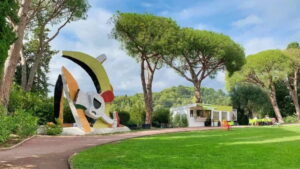
The museum underwent a renovation in 2004, resulting in the opening of the west façade with a bay window, which restored transparency to the entrance hall and revealing a view of the park with its Mediterranean plants. The garden is a very pleasant, shaded parkland and offers multiple viewpoints to admire the mosaics that cover the façades of the building. Note that the museum is closed on Tuesdays.
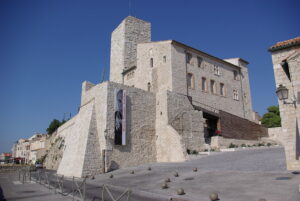
Further along the coast in the direction of Cannes is Antibes where you’ll find the incredible Picasso Museum in the Old Town right on the sea front, in the beautiful Château Grimaldi. This was built upon the foundations of the ancient Greek town of Antipolis, which became a Roman castrum and later, a Medieval bishopric. It was then owned until 1608 by the Grimaldi family, giving the Château its name, and from 1792 during the Revolution it was seized and turned into the local Hotel de Ville until the Bourbon Restoration when it was transformed into a barracks in 1820, before finally being taken over by military engineers until 1924.

In 1946 Picasso spent a very happy year in Antibes using the 2nd floor of the château as his workshop, and at the end of that year gave several important works to the city, including 44 drawings and 23 paintings, among them some of his most famous works. During this time, Picasso worked with a reduced palette of only 12 colours, using only the paint he could buy at the local hardware store—the same paint that the fishermen used for their boats!
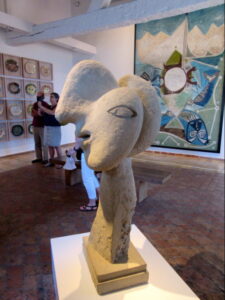
September 1947 saw the official inauguration of the Picasso room on the 1st floor, accompanied by a first hanging of the Antibes works. A year later an exhibition confirmed the addition of 78 important ceramics made at the Madoura workshop in nearby Vallauris. In September 1949, on the occasion of the inauguration of the ‘French Tapestries’ exhibition, new rooms dedicated to Picasso’s paintings, ceramics and drawings were opened to the public. In December 1966, the city of Antibes once again paid tribute to Pablo Picasso: the Château Grimaldi officially became the Picasso Museum, the first in the world to be dedicated to the artist. Finally, in 1991, the Jacqueline Picasso donation further enriched the Picasso collection.
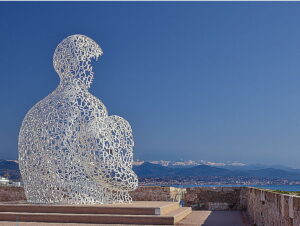
A number of other artists’ works are on display in the Picasso Museum, including Nicolas de Stael, Modigliani, Picabia and Calder, as well as sculptures by Germaine Richier, Joan Miro and others. The Regional Acquisition Fund for Museums and the Association of Friends of the Picasso Museum actively raise funds to acquire other artists’ works such as Jaume Plensa’s 10m high ‘Nomade’, installed on the Museum’s terrace in 2010
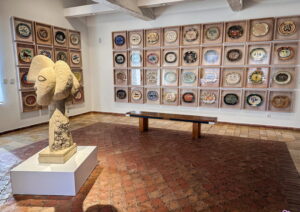
Getting there from Nice is easy. Just take the train from Nice Ville and alight at Gare d’Antibes, which takes around 25 – 30 mins. The station is about 1 km from the Museum, which you can easily walk, or take a local bus to Porte Marine. There is a bus from Nice, the no. 200 or 620, but it is very slow, taking well over an hour. Ask the Nice Tourist Office for details. Note: the Museum is closed on Mondays.
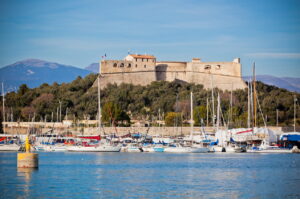
Antibes is famous for its thriving superyacht port, Port Vauban. With around 1,500 berths, it’s the largest marina in Europe. The Billionaires Quay is one of the rare quays where yachts larger than 100m can moor. On a small peninsula you can see the majestic 16th century Fort Carré looming 26m above the sea. Port Vauban separates Fort Carré from Old Antibes.
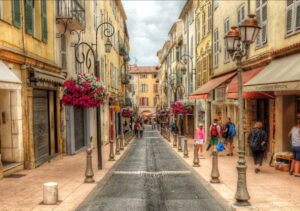
Antibes itself is well worth exploring. Surrounded by its ramparts built by Vauban in 1698, Old Antibes is especially fascinating. From Porte Marine, take the Rampe des Saleurs and head off in almost any direction to wander through the alleys, observing the hidden details on the façades and doors, the scent of flowers, enjoy a drink in a sun-soaked footpath café, or cool off with a locally made ice-cream. In due course, you’ll reach the Cathedral de Notre Dame de Platea and the steps of the Château Grimaldi. If you’ve not done so already, head up the stairs and take in the view from the top.
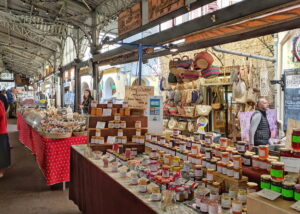
Not far from the Picasso Museum in Cours Massena the Marché Provençal takes place every morning (except Mondays during winter). Regarded as one of the best in the region, this covered market offers a wonderful and diverse range of local produce, including spices (I always buy a couple of things here), cheeses, flowers, fruit and vegetables, olive oils, jams, and locally made charcuterie.
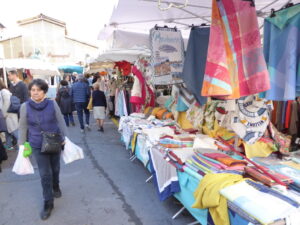
Antibes also has a Foire (flea) market in various locations scattered around, as well as a Brocante (2nd hand) market also in various locations, depending on the day of the week. There’s also an Artisan crafts market, held in the covered market in Cours Massena during summer in the afternoons from 3.00pm, when the produce market has finished for the day.
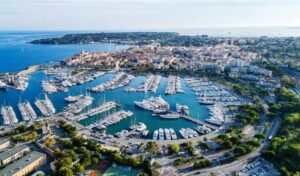
Antibes is famous for its thriving superyacht port, Port Vauban. With around 1,500 berths, it’s the largest marina in Europe, the Billionaires Quay. Port Vauban separates Fort Carré from Old Antibes.

The Riviera has such a lot to offer the visitor, aside from the expected glamour hot-spots, and from Nice it’s easy to reach many of the great sights by the excellent public transport if you don’t have a car. We prefer not to be there in the height of summer, as it’s not just the heat, but the crowds that can make exploring something of a challenge. Choose your timing, and you’re sure to want to return and see more of the attractions that one visit simply can’t take in!
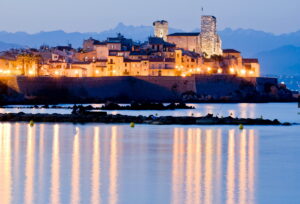


Thanks once more Cheryl. I’m planning on going to Europe in September next year .
This is very helpful as I plot my itinerary.
Cheers, Lois
Hi Lois,
So delighted you’ve found the story useful. Please drop me a line if you’ve got any trip planning questions you think I might be able to assist with.
Cheers, Cheryl